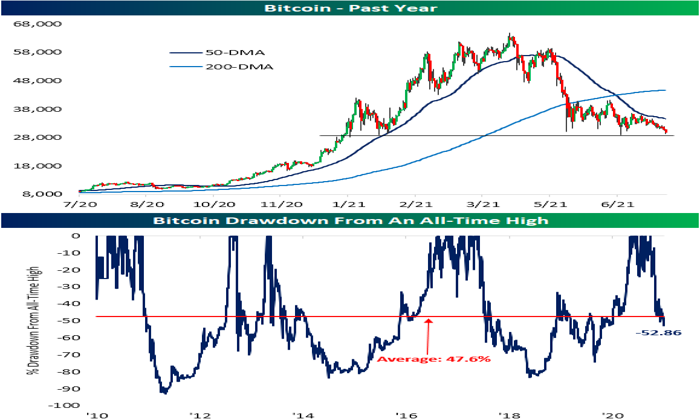Bitcoin drawdown has recently widened to a staggering 27%, bringing echoes of the tumultuous FTX collapse back to the forefront of cryptocurrency discussions. This decline is heavily influenced by the escalating US-China trade tensions, which have destabilized global financial markets and eroded investor confidence. As Bitcoin’s price analysis reveals, nearly 25.8% of the circulating supply is currently underwater, leaving many holders experiencing significant unrealized losses. Market recovery seems uncertain as geopolitical frictions continue to weigh heavily on the digital asset landscape, highlighting the fragile nature of cryptocurrency market trends. In these tumultuous times, understanding the factors contributing to Bitcoin’s drawdown is essential for both investors and enthusiasts alike.
The recent reduction in Bitcoin’s value—a term often referred to as drawdown—reflects significant market volatility that many investors are keenly observing. As cryptocurrencies face pressures from multiple fronts, including geopolitical strife and economic uncertainties, alternative financial instruments also react to the shifting landscape. In light of ongoing factors like US-China trade disputes, the broader implications for the cryptocurrency market are more pronounced, affecting not just Bitcoin but also Ethereum and others. This current downturn might seem alarming, yet it serves as a stark reminder of how external influences like global tariff negotiations impact the dynamics of digital currencies. As the market grapples with potential recovery strategies, investors must remain attentive to emerging trends and analyses surrounding Bitcoin and its peers.
Understanding Bitcoin Drawdown and Its Implications
Bitcoin’s drawdown has become a significant point of analysis for investors and traders, particularly as it has widened to 27%, reminiscent of the troubling times following the FTX collapse in late 2022. This drop is indicative of market volatility and creates a landscape fraught with uncertainty. As Bitcoin prices fluctuate remarkably in response to geopolitical events such as the escalating US-China trade tensions, understanding the drawdown’s implications becomes essential for stakeholders in the cryptocurrency market.
As of now, the percentage of Bitcoin’s circulating supply underwater stands at a concerning 25.8%, according to insights from CryptoQuant. This statistic reflects the sentiment in the market where many holders purchased their assets at a price higher than the current market rate. Such significant drawdown figures typically signal a potential for recovery; however, it also points to increased selling pressure and investor reluctance, which can dramatically shape future market trends and dynamics.
The Impact of FTX Collapse on Bitcoin’s Market Stability
The FTX collapse in late 2022 left a significant dent in investor confidence across the cryptocurrency landscape, a sentiment that continues to influence Bitcoin’s trajectory today. The pandemic of negative sentiment, combined with ongoing geopolitical disputes—particularly between the US and China—has compounded existing vulnerabilities within the market. As evident in current Bitcoin price analysis, the repercussions of FTX have defined trading behavior, leading to increased caution among investors.
While the market has witnessed a brief respite due to temporary tariff announcements, the underlying issues remain. The FTX collapse served as a definitive benchmark for peak market anxiety, and the resilience of Bitcoin continues to be tested against such historical lows. Recovery from here would require not only stabilization in US-China relations but also substantial confidence building through transparency and regulation within the cryptocurrency sphere.
Geopolitical Tensions and Their Relationship with Bitcoin Prices
The ongoing geopolitical tensions, notably US-China trade disputes, have substantial ramifications on Bitcoin prices and overall market behavior. With alarming threats of escalated tariffs looming in the background, investors are understandably jittery. This geopolitical uncertainty often translates into highly negative market sentiment, pushing Bitcoin prices downward and widening the drawdown. As we scrutinize current cryptocurrency market trends, it becomes evident that external political and economic factors play a pivotal role in Bitcoin’s performance.
Moreover, the relationship between geopolitical stability and asset prices can’t be underestimated. The historical patterns indicate that when countries engage in trade tensions, investors often flock to safer assets, and Bitcoin, despite its volatility, has emerged as a significant form of digital gold. Nevertheless, as tariffs increase and economic relations sour, Bitcoin may face continuous pressure, prompting further analysis into levels of support and resistance, ultimately shaping the recovery narrative moving forward.
The Current State of Bitcoin and Market Recovery Signals
In the wake of the recent Bitcoin drawdown, many investors are eyeing signs of market recovery that could pave the way for a renewed bullish trend in the cryptocurrency sector. Indicators suggest that despite the discomfort caused by geopolitical frictions and macroeconomic instability, Bitcoin’s historical resilience might indicate a forthcoming rebound. Assessing bitcoin markets through thorough price analysis, there are whispers of underlying support levels that, if respected, could lead to a gradual recovery from the current lows.
Additionally, market analysis shows that while the price downturn has affected a large portion of Bitcoin supply, historical trends suggest that all bear markets are eventually followed by recovery phases. This continued decline could lead to the forced capitulation of weak hands, allowing stronger or more committed investors to capitalize at lower prices. As observed in previous bear market cycles, those who remain patient might benefit the most as Bitcoin adjusts and prepares for its next potential ascent.
Future Outlook for Bitcoin Amidst Market Volatility
The future of Bitcoin, shaped by current market volatility, hinges on various interconnected factors. Not only are traditional financial dynamics, such as inflation rates and market confidence influencing prices, but emerging global socio-economic relations are playing an increasingly vital role. As analysts monitor Bitcoin drawdown statistics, they project that a recovery is feasible in the face of a bear market, contingent upon how geopolitical tensions might ease.
Moreover, as cryptocurrency markets adapt to ongoing changes, Bitcoin’s unique features as a decentralized digital asset may become more appealing. If governments, particularly those embroiled in trade wars, continue to reassess their financial strategies, Bitcoin could emerge as a preferred alternative in a shifting financial landscape. Observing these intersections will be crucial for investors as they ponder the strength and longevity of their crypto portfolios.
Navigating Bitcoin’s Price Analysis in a Complex Economic Climate
Conducting thorough Bitcoin price analysis is becoming increasingly critical as the economy grapples with multifaceted challenges. The collapse of the FTX market, coupled with geopolitical turbulence, has shifted the landscape significantly, where any price action viewed now must consider macroeconomic indicators. Bitcoin’s jump from speculative asset to more institutional backing requires an observant lens as stakeholders react to real-time volatility.
In evaluating price trends, incorporating various tools such as technical analysis, market sentiment measures, and understanding the broader economic implications can significantly assist in making informed investment choices. Investors must remain adaptable, using data-driven insights to anticipate market movements. With the correct approach, navigating through these turbulent waters might provide opportunities for growth and recovery in Bitcoin markets.
Interconnectedness of Bitcoin with Global Economic Factors
The interconnectedness of Bitcoin with global economic factors cannot be overstated in the current climate. Events such as the US-China tariff discussions serve as pivotal reminders of how international relations directly affect cryptocurrency prices. Investors must be acutely aware that shifts in trade policies or significant political disruptions can lead to immediate volatility in Bitcoin and other cryptocurrencies, as investor sentiment often parallels broader economic fears.
Moreover, the ripple effects of these economic factors can shape cryptocurrency adoption rates, investment strategies, and market stability. Understanding this intricate web is essential for any investor looking to thrive in the world of digital assets. Market watchers should remain informed about these dynamics to anticipate shifts in Bitcoin’s market posture amid relative geopolitical calm or turmoil.
Long-term Trends in Cryptocurrency Market Recovery
Long-term trends in cryptocurrency market recovery emphasize Bitcoin’s role as a cornerstone asset. Despite the current challenges, historical data reveals that significant downturn events have ultimately led to remarkable recoveries in the past. As evident from earlier bear markets, Bitcoin has demonstrated resilience and a tendency to bounce back stronger after undergoing prolonged periods of consolidation and correction.
This tendency is crucial for both casual and institutional investors, hinting at potential investment strategies that capitalize on market fluctuations. Long-standing holders often view market pullbacks as opportunities, aligning their portfolio strategies with anticipated future growth phases. Such trends underline the importance of patience and informed decision-making in navigating Bitcoin’s cyclical nature.
Strategies for Investors Amidst Bitcoin’s Market Fluctuations
Given the recent Bitcoin drawdown and market fluctuations, investors must develop robust strategies to safeguard their investments. Some recommend dollar-cost averaging during downturns— a method that spreads out the investment over time to mitigate risks associated with turbulent prices. Employing this approach enables investors to capitalize on price dips, potentially leading to substantial returns in subsequent recovery phases.
Additionally, diversifying one’s portfolio to include not just Bitcoin but also other cryptocurrencies and traditional assets can provide a buffer against volatility. As the cryptocurrency market continues to evolve, adaptable investment strategies that combine risk assessments with economic forecasts will be essential for navigating the complexities of Bitcoin’s ever-changing landscape.
Frequently Asked Questions
What is the current Bitcoin drawdown status amid US-China trade tensions?
As of April 2025, Bitcoin’s drawdown has widened to 27%, placing it near the levels observed during the FTX collapse in late 2022. This increase in drawdown has been attributed to escalating US-China trade tensions that have created uncertainty in global financial markets.
How does the drawdown in Bitcoin relate to the FTX collapse and cryptocurrency market trends?
The current Bitcoin drawdown of 27% is reminiscent of the FTX collapse, which also triggered significant market disturbances. The cryptocurrency market trends indicate that geopolitical issues, like the US-China trade conflict, can heavily influence Bitcoin’s price movements, contributing to the asset’s volatility.
What percentage of Bitcoin supply is currently underwater due to recent drawdowns?
Recent data reveals that approximately 25.8% of Bitcoin’s circulating supply, equating to about 5.12 million BTC, is currently underwater, meaning these coins were purchased at prices above the current market rate, resulting in unrealized losses for many holders.
How do US-China trade tensions affect Bitcoin’s market recovery and drawdown?
US-China trade tensions have adversely affected Bitcoin’s market performance by diminishing investor confidence, leading to a significant drawdown. While historical market recoveries have occurred post-drawdowns, current geopolitical frictions could prolong Bitcoin’s recovery period.
What can we learn from past Bitcoin drawdowns in relation to market resilience?
Past Bitcoin drawdowns, such as the 83% drop in 2018 and a 73% decline during the 2022 downturn, show that while the asset does experience significant declines, it often rebuilds over time. Understanding these patterns can help investors navigate current market conditions more effectively.
| Key Point | Details |
|---|---|
| Bitcoin Drawdown | Currently widened to 27%, close to FTX collapse levels. |
| Market Pressure | Escalating US-China trade tensions are affecting market stability. |
| Underwater Supply | 25.8% of Bitcoin’s supply (5.12 million BTC) is currently underwater. |
| Historical Context | Current drawdown is modest compared to past declines: 83% in 2018 and 73% in 2022. |
| Market Observations | Geopolitical issues have lowered investor confidence impacting crypto markets. |
Summary
Bitcoin drawdown has reached a significant level of 27%, mirroring conditions seen during the FTX collapse. This increase is largely attributed to rising trade tensions between the US and China, which have placed considerable strain on both traditional and crypto markets, making 25.8% of Bitcoin’s circulating supply effectively underwater. Historical comparisons showcase that although the current decline is troubling, it remains comparatively mild when viewed against the backdrop of previous crypto bear markets. Investor sentiment remains fragile amid these geopolitical uncertainties, underscoring the volatility inherent in the cryptocurrency space.
The recent Bitcoin drawdown has widened to a staggering 27%, mirroring the unsettling conditions experienced during the FTX collapse in late 2022. Amid escalating US-China trade tensions, which have created significant uncertainty within the cryptocurrency market, Bitcoin price analysis reveals that 25.8% of its circulating supply is currently underwater. This downturn has been exacerbated by broader macroeconomic factors, leading many investors to confront unrealized losses on their holdings. Despite a momentary pause in tariffs announced by Donald Trump, the market remains turbulent, raising questions about the potential for a Bitcoin market recovery. Understanding the implications of these cryptocurrency market trends is crucial for both seasoned and new investors navigating this volatile landscape.
In recent weeks, Bitcoin has faced an unprecedented decline, often referred to as a market pullback, following the chaotic aftermath of the FTX incident. The impact of ongoing trade disputes between the US and China is creating ripples throughout the financial sector, influencing investor behavior and leading to substantial losses in the digital currency space. This situation has forced traders to reassess their positions as the percentage of Bitcoin supply sitting at a loss grows alarmingly. As analysts delve into the factors contributing to this downturn, insights regarding the potential recovery of Bitcoin and other cryptocurrencies remain imperative for understanding future market movements. Looking closely at these shifts helps decipher trends that could define the upcoming landscape in digital finance.















